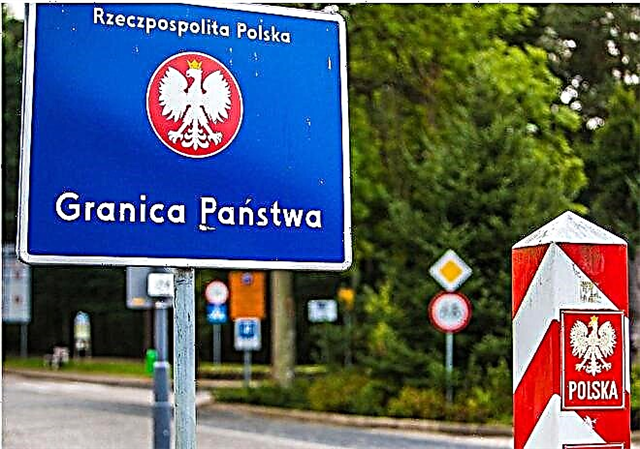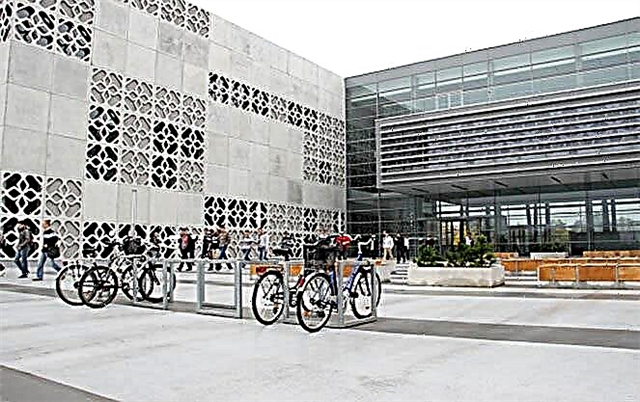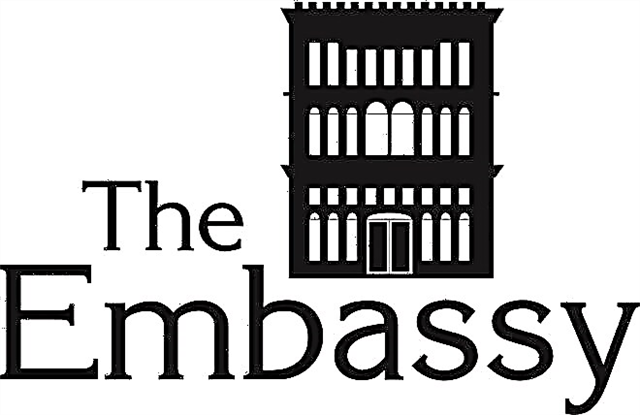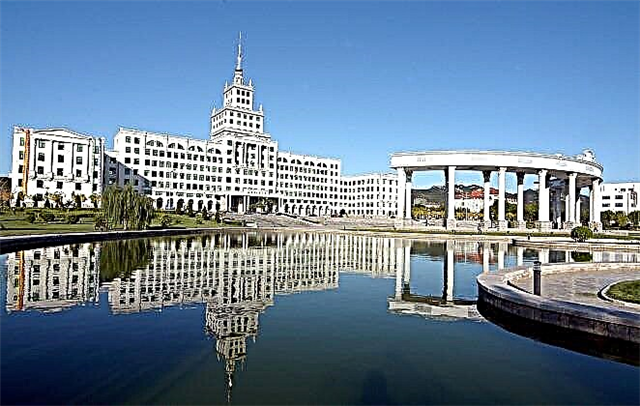The Düsseldorf Rathaus (Düsseldorf Rathaus) is today the building of the city government. In 1985, she entered the list of architectural monuments that are under state protection. It is easy to get to the Town Hall from anywhere in Dusseldorf, because it is located in the center of the Old Town.

Historical summary
The ancient city of Dusseldorf is located on the banks of the Rhine - a major river in Germany. The first mentions of the city, according to historians, date back to the first half of the 12th century. The Second World War made its own adjustments to the appearance of the ancient city: little is left of the old Dusseldorf, but architectural monuments have survived, including the town hall.
The very first city hall in Düsseldorf was located next to the building of the temple of St. Lambert. The second house of the council, known as the "House of the Black Horn", was located near the monastery church of the Holy Cross Brothers.

Only in 1500 was the construction of the town hall completed on the Market Square (Marktplatz) near the Rhine embankment. Since then, the city authorities have been invariably located in this council house.
Today's building consists of three parts - wings, the main architectural style of which is the Renaissance. However, features of other styles are noticeable on the facade of the building, because parts of the town hall were rebuilt over several hundred years.
Architectural features
The project for the construction of the Dusseldorf Town Hall turned out to be quite expensive, but they managed to translate it into reality, because the building was of paramount importance for the city. The wings (parts) of the town hall all together form the letter "P". The two fronts of the council house are curved. The five-storey tower has eight faces; you need to climb it up a beautiful spiral staircase.
However, immediately after the construction, the Düsseldorf Town Hall was not so attractive. In some places, even a hewn stone could be seen in the building, because the walls were not covered with plaster.
The first wing is the oldest part of the building, the façade of which overlooks the Marktplatz. The building was built in the years 1570-1572.
Several styles have been mixed in architecture. The features of the late Gothic and Renaissance are clearly visible.
The main entrance to the building was located in the staircase tower. The building was designed by Alexander Pasqualini. Red bricks were chosen as the main material for the construction.
It is interesting that two large halls were equipped on the first floor. In these premises, artisans and weavers could sell their goods. Here one could buy, for example, finished products, wool and other materials. We can say that it was the first covered market in the city.
In the 18th century, the Old Town Hall underwent a major reconstruction. In the course of construction, the front of the building began to acquire rococo features, and the main entrance appeared not far from the tower. It was very convenient, because before that it was only possible to enter the town hall through the tower.
The floors were now separated from each other by pilasters; a beautiful openwork balcony was equipped above the new front entrance. The author of this project was Johann Josef Koufen. During World War II, the building, like many others in Germany, was damaged. At the end of the war, the town hall was restored and slightly expanded.
The second wing overlooks the Burgplatz. Previously, an art gallery was located in its place. The building has undergone reconstruction throughout its history. The facade received its present appearance only in 1920.
The third part is the building that once housed a school of applied arts. The wing was erected in 1883 in the neo-Renaissance style.
The facade of the building is built of yellow bricks, many elements of the architecture are made of stone. The building acquired its present appearance only after the war.
The wing was built according to the project of the architect Eberhard Westhoffen. Interestingly, all three parts of the town hall were designed by different people.

Today, the interior of the town hall has been completely redesigned in a modern style. However, in one of the halls, the standards of the meter and the Prussian polod, made of metal, have been preserved. The exhibits are embedded in the wall.
A portrait gallery is located in the hall where the meetings of the council of elders are held. In the ceremonial hall on the second floor, the chief burgomaster receives guests.
Neighborhood of the town hall
So, the first wing overlooks the Marktplatz. There are many more interesting sights in the vicinity of this part of the building. The market square (Marktplatz) is the central square of the old part of the city of Dusseldorf. Düsseldorf is the capital of the federal state of North Rhine-Westphalia.
An equestrian monument to the Elector of the Palatinate Johann Wilhelm is erected on the square. The sculpture was designed by Gabriel de Grupelo.
The trapezoidal square has the following dimensions: from west to east - 55 m, from north to south - 52-58 m. - Burgplatz square.
In the eastern part there are a number of buildings, on the ground floors of which there are cafes, restaurants and various shops. On the square, 4 objects are taken under state protection:
- town hall;
- residential building in the baroque style;
- monument to Johann Wilhelm;
- administrative building.
The square is located directly on the banks of the Rhine.
If you arrive in Düsseldorf on Christmas Eve, you can combine a tour of the town hall with a visit to the Christmas market.
Every year (November 11) on St. Martin's Day, a carnival takes place on Marktplatz, scenes from the life of St. Martin are performed on the stage. At the end of November, the main Christmas tree of North Rhine-Westphalia is set up in the center of the square.
The second wing of the Düsseldorf Town Hall overlooks the Burgplatz (town square). Today, this square is a favorite pedestrian zone for residents and guests of the city.
Many interesting events are held at Burgplatz. Every year on the square there are:
- jazz festivals;
- days of France and Japan;
- book fairs;
- bike days;
- ski racing.
The town square is the centerpiece of the Rhine promenade. The castle tower houses the Museum of Shipping and Navigation.
As stated above, not far from the town hall is the Catholic Church of St. Lambert. The basilica was created in the Romanesque style. True, nothing has survived from the first building. This church is famous not only for Christian events, but also for secular ones. In 1585 it became the center of the festive event in honor of Jan Willem's wedding. Duke William V was buried in the church in 1592.

In the Old Town, especially in the vicinity of the Dusseldorf Town Hall, there are many beautiful and interesting places, buildings where you can go on an excursion. Therefore, going to the town hall, you can explore the entire historical part of the city along the way.
Here you can take a lot of beautiful photos, have a tasty snack in local cafes and just take a walk.
Excursion to the Dusseldorf Town Hall
Every Wednesday at 15:00, anyone can visit the Düsseldorf Town Hall for free. A good option for tourists who want to safely explore the attraction and save money.
A guided tour lasts 1 hour 15 minutes. The story is in German. Inside the council house, you can take photos, ask questions during the tour.
The tour begins in the hall where the city government sits. The room is rather modest, the walls are decorated with carvings. Visitors are allowed to sit in the chair of the deputy.
The town hall was badly damaged during the war, the baroque part of the building was completely destroyed. The interiors could not be saved.
In one of the rooms, the walls are decorated with stove plates, which were donated by one collector as a donation to the city.These slabs are associated with the industrial past of this area, which in itself is symbolic, because this town hall is the place where important decisions are made regarding the fate of Düsseldorf.
Other sights from different eras have also been preserved inside the council house. We can say that this is a unique architectural monument where the present is intertwined with the past, because ancient sculptures and paintings look very original in modern rooms.
The building has a wood-paneled gallery displaying an old German flag.
One room is entirely dedicated to Heinrich Heine, who was born in Düsseldorf. His bust is installed here.

Interestingly, within the walls of the Düsseldorf City Hall hangs a painting by Wilhelm Schroyer "Russian troops at the crossing of the Rhine on January 13, 1814", opposite there is a marble monument of Jan Willem.
An entire room is devoted to portraits of the burgomasters of the city. Here you can see how fashion, painting styles and faces have changed.
Also in the town hall you can see narrow spiral staircases, massive doors and a special mark that reminds of the water level in one of the floods.
After exploring the interior, the tour continues in the courtyard. Admission there is free and without a guided tour, but only during the day.
Examining the buildings from the outside, you will notice a harmonious combination of different styles: Renaissance, Gothic, Baroque, Rococo. Modern walls are intricately intertwined with ancient facades. The courtyard itself is quiet and cozy.
At the Düsseldorf City Hall, you can borrow various brochures, children's literature, books about Düsseldorf, as well as a city guide for free. For those who love tinkering, there is even a book with a town hall layout that needs to be glued.
Location and how to get there
The Düsseldorf rathaus is located in the center of the Old Town. You can get to the building by metro. And from the railway station of the city, the road to the town hall will take only 30 minutes on foot.
Note that the same tickets are valid for all types of urban transport, which can be purchased from special machines at stops. You can also buy a travel document from the driver. Expired tickets do not need to be punched.
Several underground lines lead to the central square of Düsseldorf: U-Bahn U74, U75, U76, U77, U78, U79.
Summarize
Düsseldorf City Hall occupies an honorable place in the heart of the Old Town. This ancient building has been the seat of the city council for several hundred years. The building has several parts (wings), which were designed by different architects. Despite the fact that the main style of architectural design is the Renaissance, here you can see elements of the Gothic, Baroque, and Rococo.
Inside, all the rooms are already decorated in a modern style, but many antique items remain.
The building is included in the list of architectural monuments, therefore it is protected by the state.
During the visit to the town hall it is allowed to take photos. Inspection begins with the interior decoration, after which you can stroll around the cozy courtyard.
The City Hall in Düsseldorf is the main attraction of the city, so a visit is definitely worth a visit, as are the Aachen Cathedral, the Berlin Opera and the incredible castles of Eltz and Herrenchiemsee.











